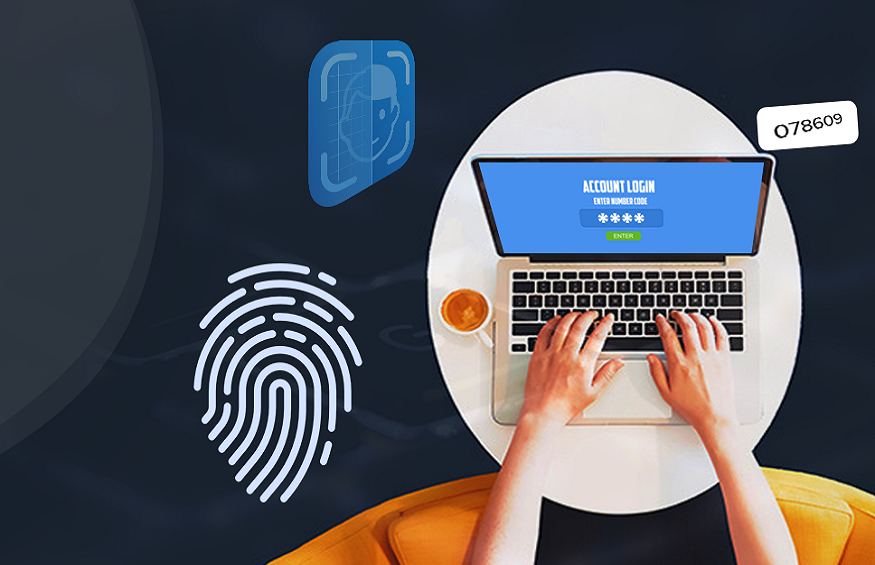How Does Passwordless Authentication Work?
In the modern world, almost every app, program, or service that you use requires some sort of password to log in, and they all have different password requirements. One website may accept a simple password like “daisy123”, but another might require you to use a capital letter and a special character. With all of these different sites and requirements, staying on top of your security passwords can be difficult. That’s where passwordless authentication comes in.
When you first hear about passwordless authentication, you might think that it can’t be as secure as a password that only you know. However, passwordless authentication is much more secure than using passwords to log in to your accounts.

What Is Passwordless Authentication?
Simply put, passwordless authentication is a type of login system that an app or website will use. Instead of logging in with a password you created, these websites have created passwordless solutions for accessing accounts. This type of login still requires authentication to ensure the right person is accessing the account. In fact, passwordless authentication does an even better job of keeping your account secure.
Types of Passwordless Authentication
There are a few different types of passwordless login authentication that a site might use. Generally, they are divided into two categories: possession factors and inherent factors.
Possession factors are usually objects or accounts that generate one-time passwords. For example, many companies will give their employees a device that generates a one-time password when you hit a button or one that the user must plug into the computer to access company information. Other examples of possession factors are when a site sends you an email or text with a link or one-time password that you use to access the site.
Inherent factors are unique to individuals, like fingerprints, faces, retinas, and more. You have likely encountered accounts that allow you to log in with your fingerprint using a scanner on your phone. Many laptops also have fingerprint scanners as well.
These methods of passwordless authentication ensure that your accounts are secure.
Benefits of Passwordless Authentication
More Secure
The most important benefit of passwordless authentication is that it is very secure, especially compared to traditional password login systems. There is virtually no way for someone to hack into your account when you use one-time passwords or biometric information.
More Affordable for Website Owner
You might not realize it, but every company website that requires a password has to store that password somewhere. It takes a lot of time and money to keep so many passwords on servers. On top of that, these companies have to pay staff to maintain the passwords and prevent hackers from stealing the information.
When a company uses passwordless authentication, they are saving money. Ideally, those savings are then used to create a better product or service for their customers or pay their employees more.
Better User Experience
Finally, passwordless authentication allows for a better user experience. Most people can probably empathize with the feeling of panic when you realize you don’t know your password.
Keeping track of all of your different passwords for various websites can be confusing and anxiety-inducing. With passwordless authentication, you never have to worry about remembering your password again.
Disadvantages of Passwordless Authentication
Your Information Is No Longer Secure if Your Device Gets Stolen
If you are using a device that provides one-time passwords and it gets stolen, they will be able to log in to your account as long as they know your user information. However, you can report the theft to your workplace or remotely disable the device in most cases.
Hackers Can Get Past Biometric Authentication
In rare cases, hackers have been able to trick the technology behind biometric authentication like facial scans and fingerprint locks.
Customers Don’t Trust Passwordless Authentication
Many people don’t trust passwordless authentication because they have always thought that passwords are bulletproof against hackers. However, passwords are proven to be weak, and passwordless authentication is much more secure.
Is Passwordless Authentication the Same as Multi-Factor Authentication?
Many sites have started implementing multi-factor authentication. You have probably come across this term, and you might have even implemented it for some of your accounts. Multi-factor authentication is a login system that requires two types of authentication.
Usually, the first authenticator is a traditional password. Once you put in the correct password, a one-time code is sent to your email address or phone number. That code serves as the second authenticator.
Multi-factor authentication is more secure than just having a password because the person logging in must know the password and have access to a specific email account or phone number. Multi-factor authentication is undoubtedly more secure than traditional passwords, but it is not the same as passwordless authentication.
Why We Should Have More Passwordless Authentication
From everything that we have discussed, you know that passwordless authentication is the way of the future. More and more apps and websites are setting up secure and encrypted ways to log in to protect their users.
Traditional password login systems are weak and can easily be accessed by the wrong people. With passwordless authentication, we can prevent this hacking from happening.Passwordless authentication prevents the following issues.
Password Spraying
This is when a hacker will try to access many accounts with just a few commonly used passwords. This type of attack is why people recommend using a non-generic password for your accounts.
Credentials Stuffing
This type of hacking happens when someone steals account login information. Hackers can sometimes access a directory of password information stored and maintained by the company that owns the site.
Spear Phishing
Spear phishing is when hackers target a specific demographic of people to try and access their account information. Frequently, hackers use spear phishing attacks to target technologically illiterate people, like the elderly.
Someone being targeted might receive an email from a supposed friend or company, asking them to divulge personal information or reset a password to a different email address. Since they seemingly know or trust the person asking for the information, they feel confident in giving it and can then be hacked.
Brute Force Attacks
These attacks happen when a hacker tries to access management accounts using every character combination available. These hackers will write algorithms that help them quickly go through every possible password until they find one that works.
These types of attacks have encouraged websites to have password length minimums. With brute force attacks, hackers can access accounts with short passwords much quicker than those with lengthy or complicated passwords.
Offline Cracking
Offline cracking is similar to credentials stuffing in that both require the hacker to steal login information. Usually, offline cracking happens when the attacker steals the actual file where password information is stored. Then, they go through the data offline.
At the end of the day, passwordless authentication is safe and secure. The benefits of this system far outweigh the few disadvantages. Users should feel safe when their information is protected by passwordless authentication.
Make Your Website More Secure
Do you own a website and need better security? Consider setting up passwordless authentication to keep your users and yourself safe from hackers. Reliable encryption software could be an easy solution for passwordless authentication and other cybersecurity measures your website needs.



